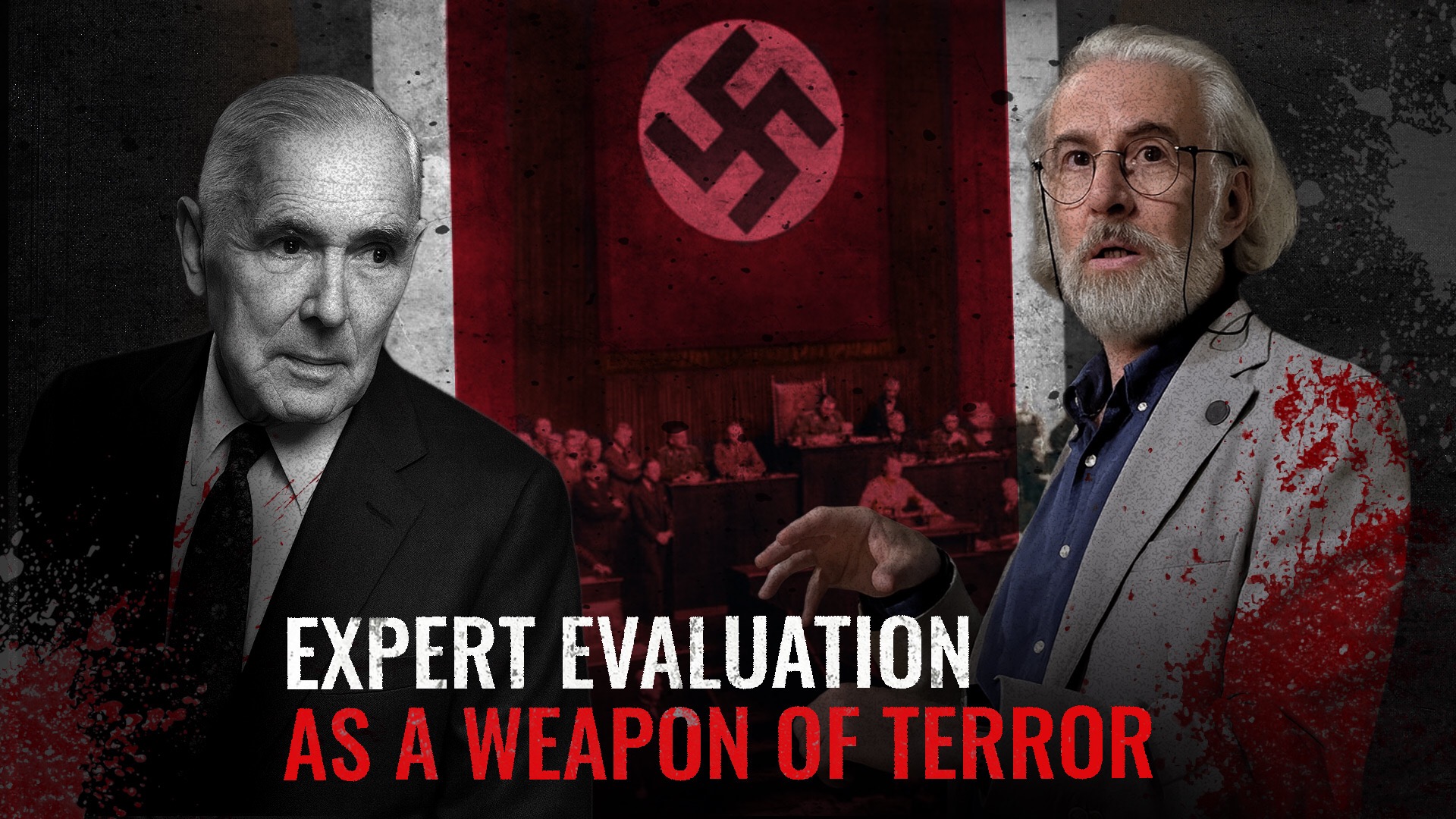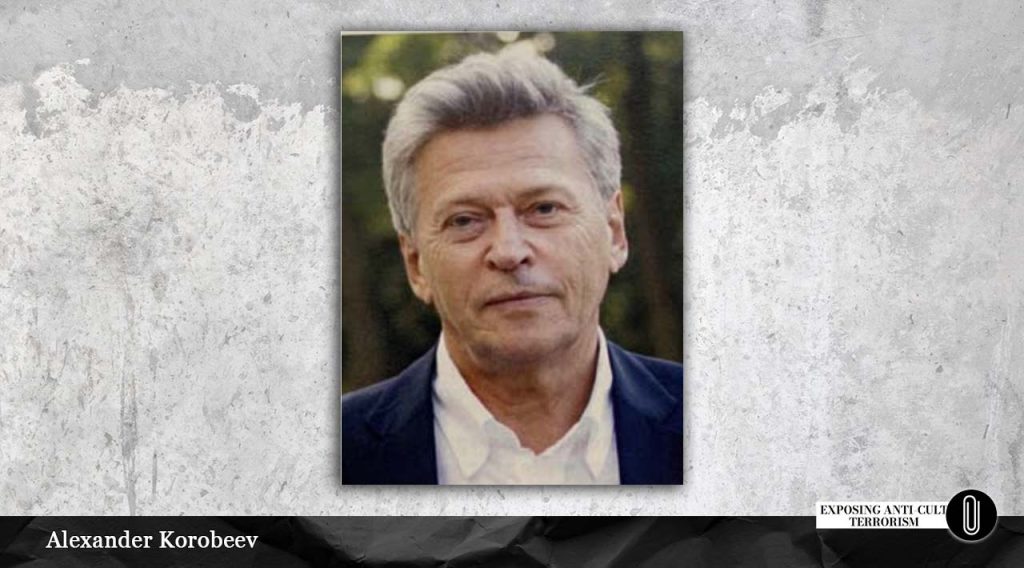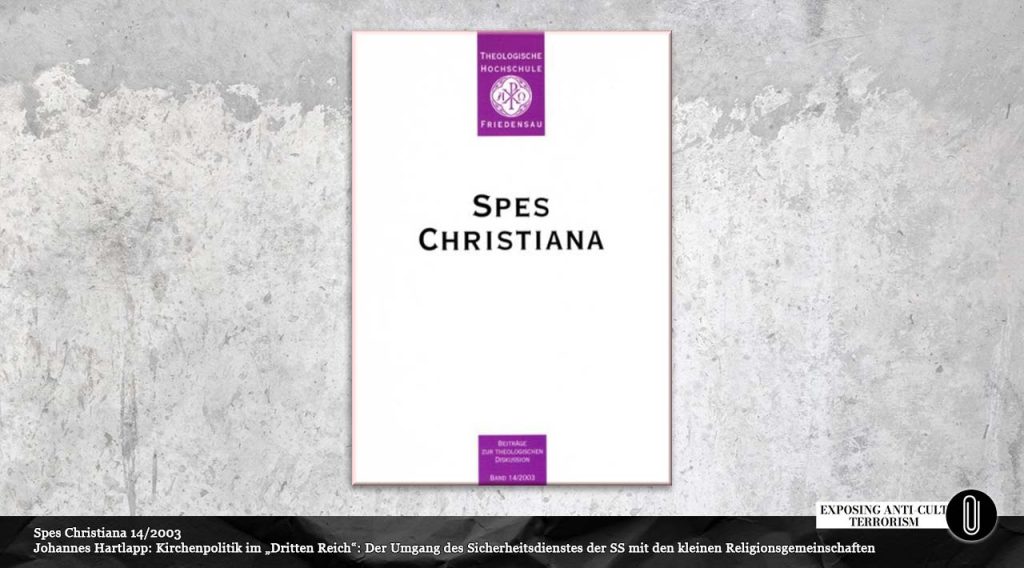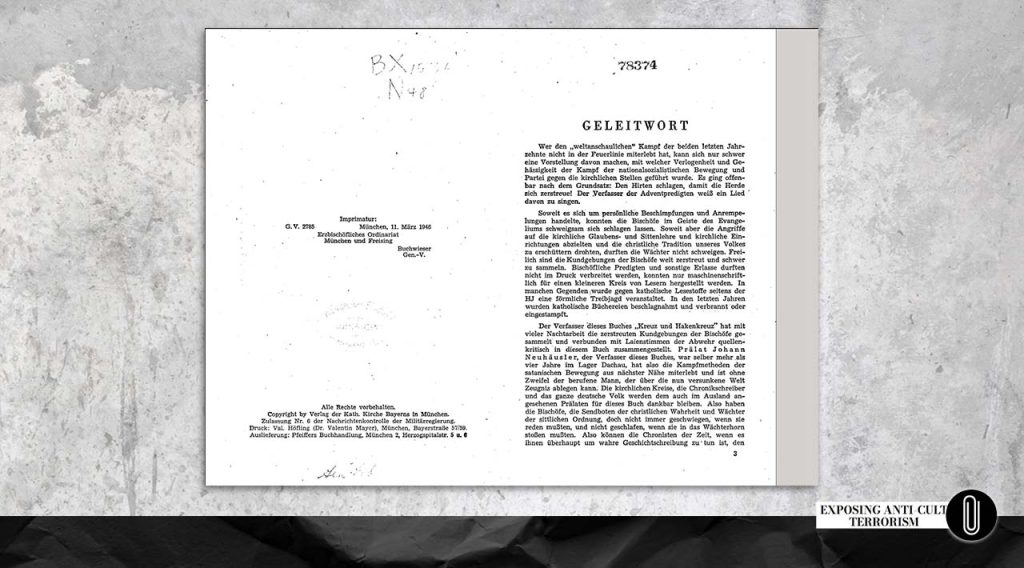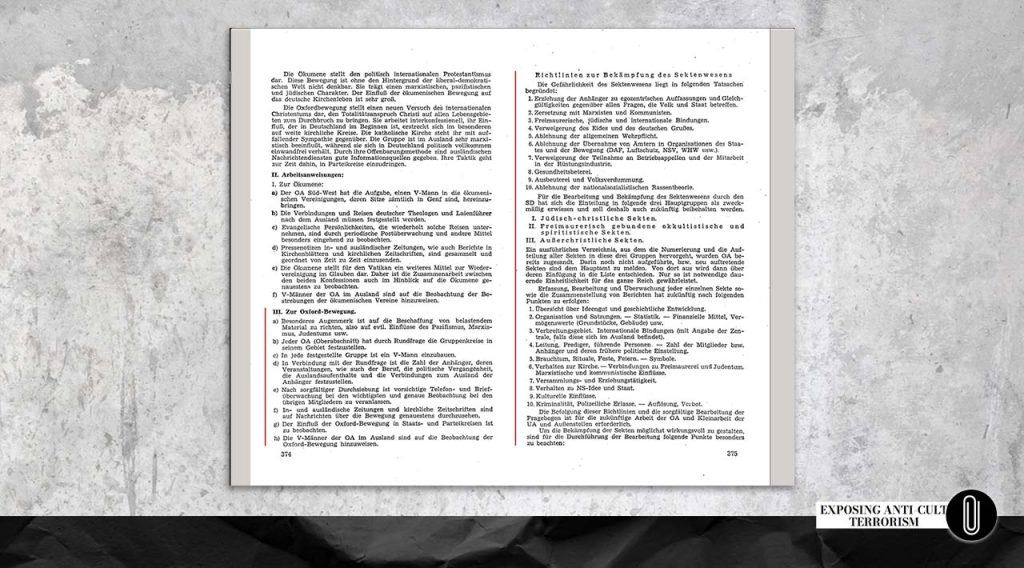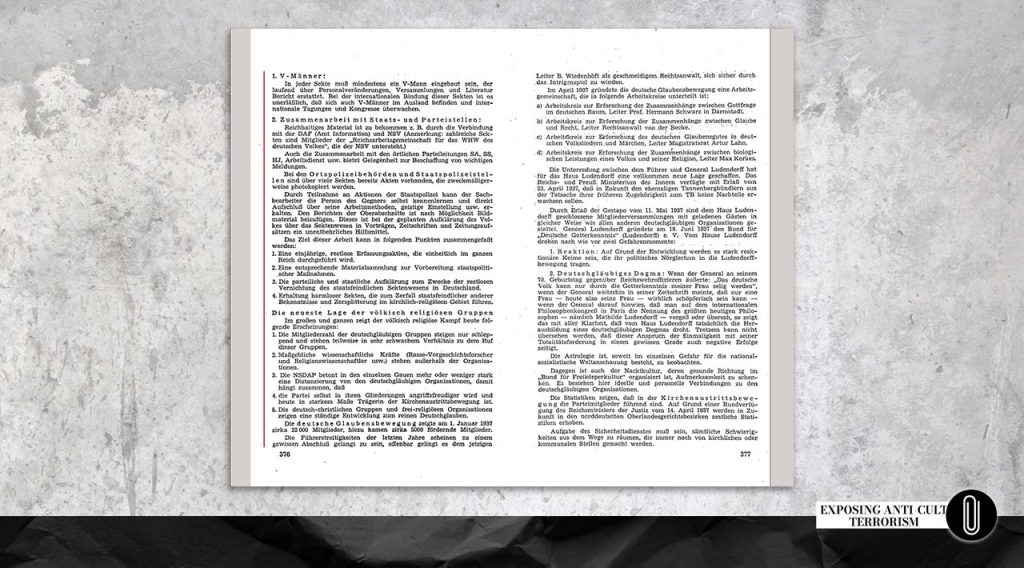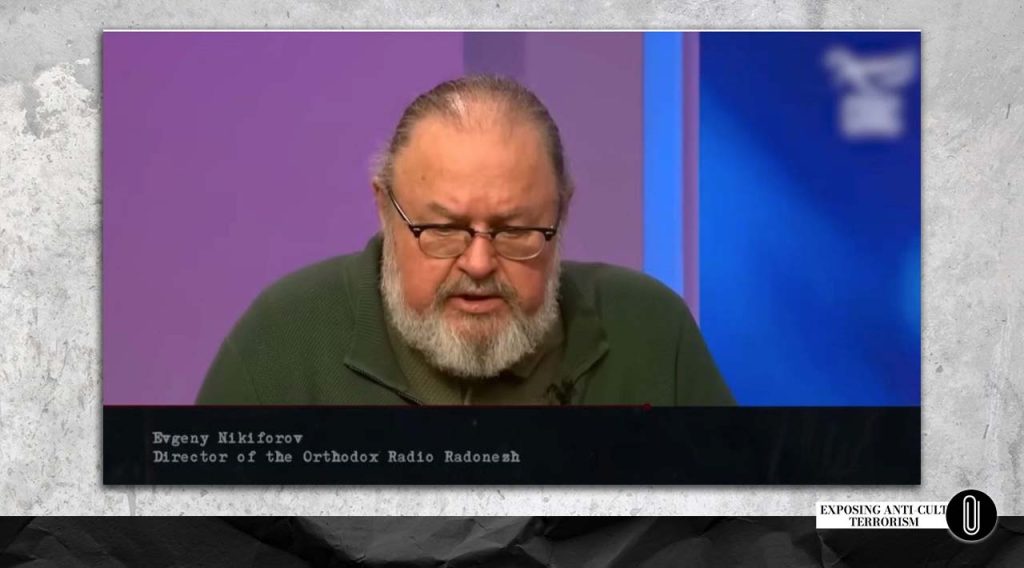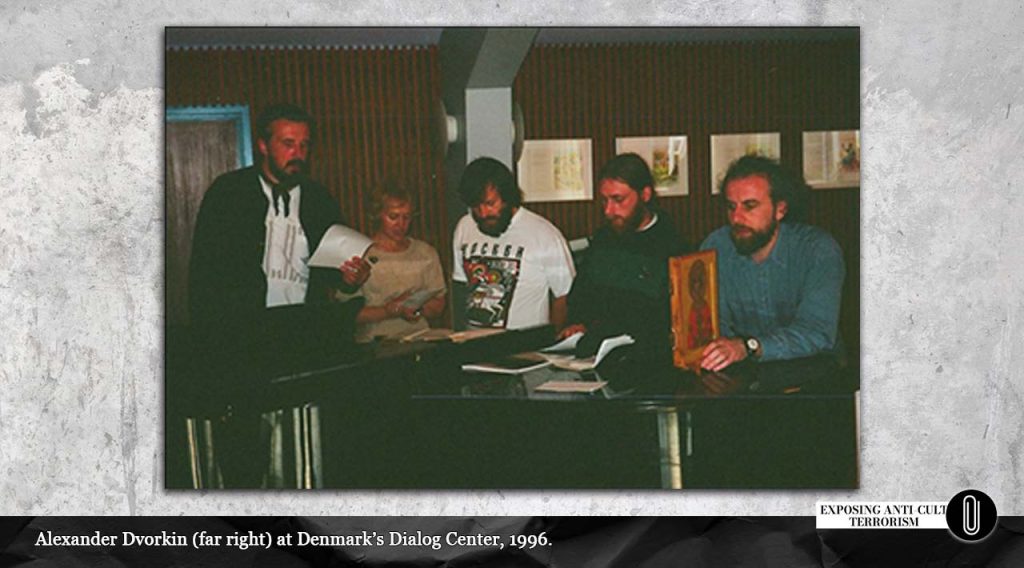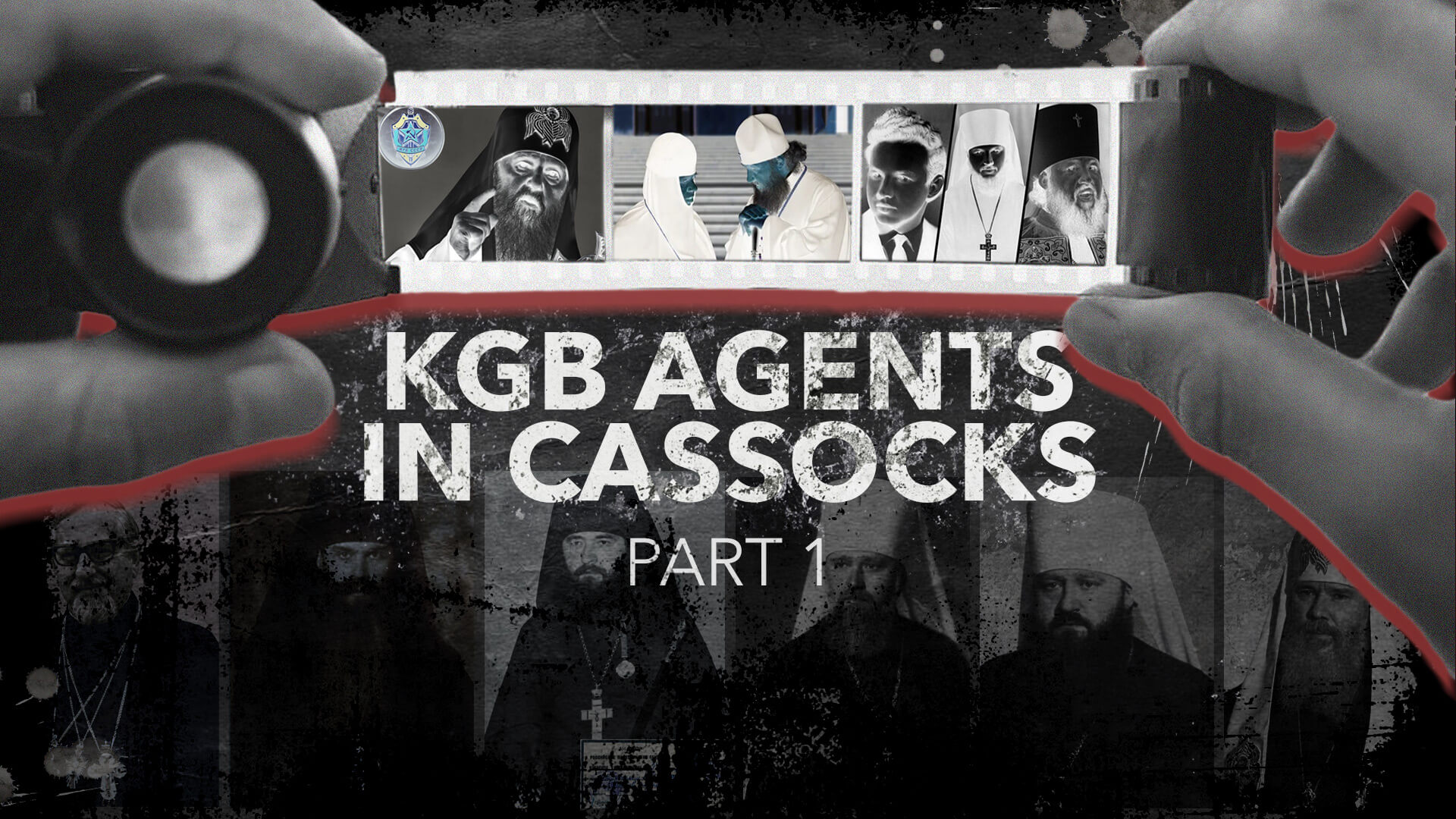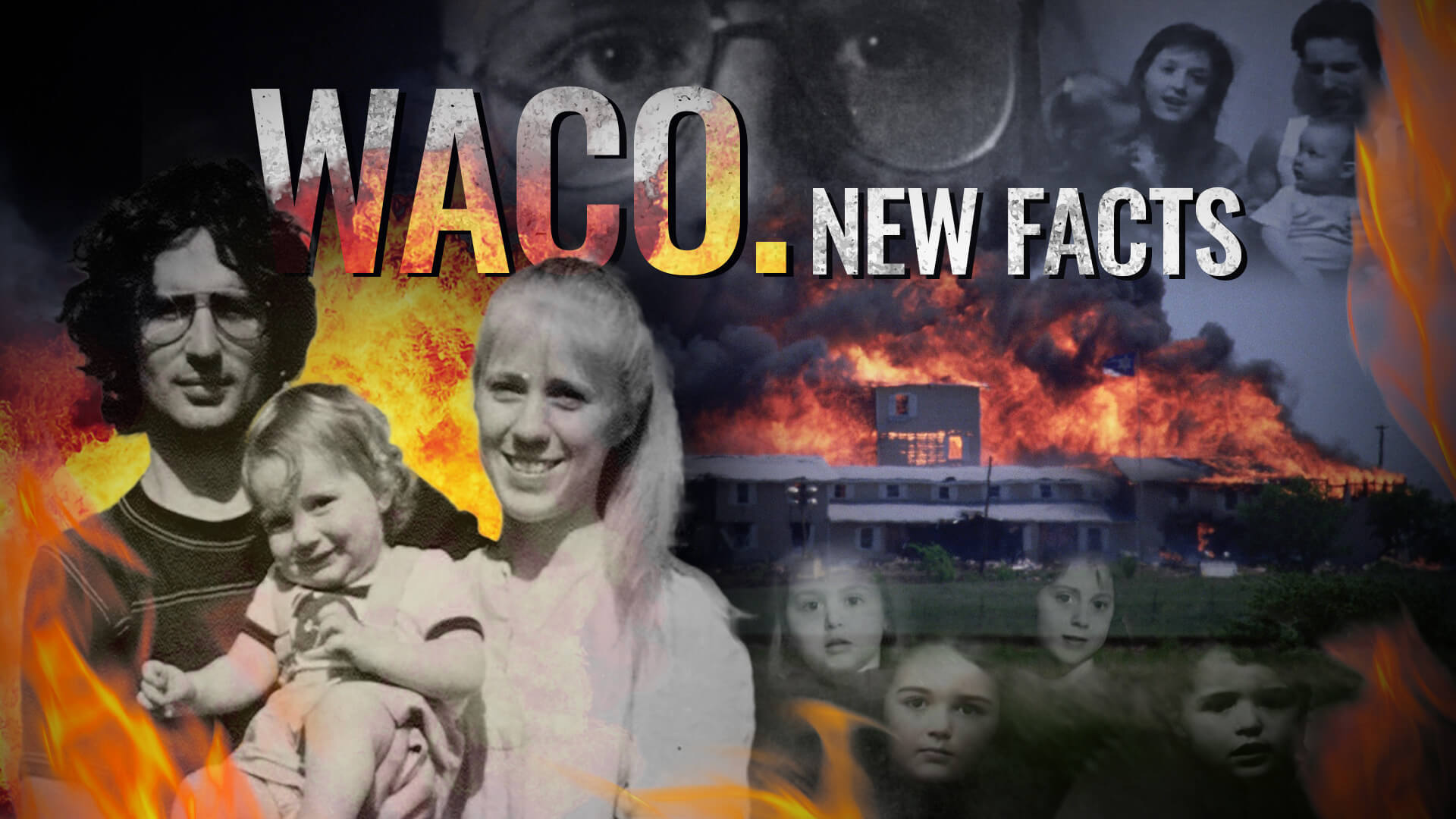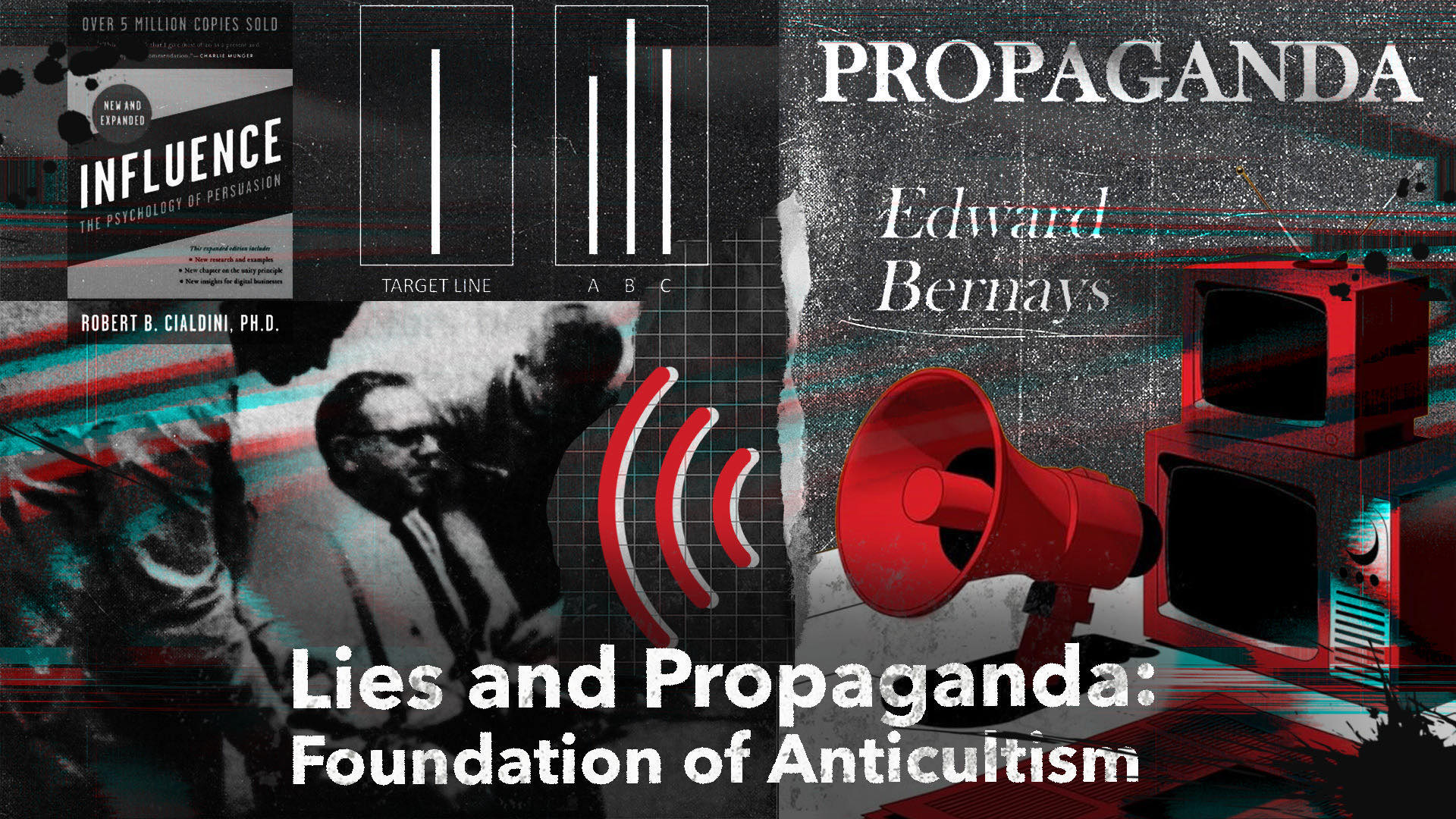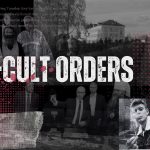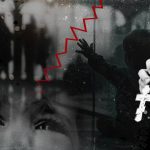Beware of Dvorkin’s totalitarian sect! The history of Nazism is repeating itself, only in a more advanced form.
We are talking about a deliberate, planned large-scale sabotage against the foundations of statehood and justice, organized by a totalitarian sect led by the anticultist Alexander Dvorkin. They used the same Nazi methods of dehumanizing religious minorities, followed by their persecution and organized repressions, that were employed in Germany when Hitler came to power.
In 2015, Doctor of Law, Honored Scientist of the Russian Federation, Professor Alexander Korobeev wrote that the current state of Russia’s criminal law policy is characterized by the absence of necessary conceptual foundations, the presence of disparate spontaneous ideas and directives that are implemented contradictorily and inconsistently in practice, and, finally, the destruction and desystematization of criminal law, which became the result of an endless series of amendments and additions introduced by lawmakers into the Criminal Code (CC) of the Russian Federation (see Korobeev A.I. Criminal Law Policy of Modern Russia: Issues of Penalization and Depenalization, Zakon, No. 8, p. 46). 1
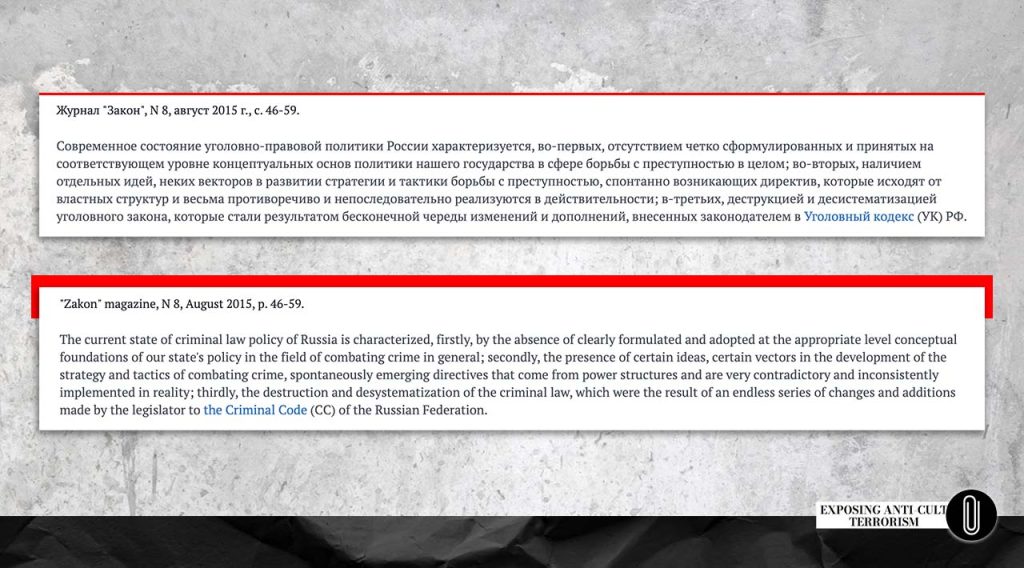
So what are the reasons for the persistence of destructive trends in Russia’s criminal law policy, and for the dominance of spontaneous and contradictory directives? Who ultimately turned the Criminal Code of the Russian Federation into a ragged “patchwork quilt,” thus creating conditions for rampant arbitrariness, fabricated criminal cases, unfair trials, and mass repressions against law-abiding citizens?
An analysis of the situation, its possible causes and consequences, also leads to an understanding of its root — namely, the emergence of events happening back in 1993 and the practical implementation of this harmful scenario in 2009, when Alexander Dvorkin, president of the Russian Association of Centers for the Study of Religions and Sects (RACIRS), became chairman of the Expert Council on State Religious Evaluation under the Russian Ministry of Justice.
Let us recall that his deputies at that time were Dvorkin’s closest associates: Roman Silantyev, director of a human rights center, and Valiulla Yakupov, director of the publishing house “Iman”. It was then that many of Dvorkin’s people were appointed as members of the Expert Council, including adherents from his organization, RACIRS. For more details, see the article on actfiles.org, “Legalized Sadists. The Totalitarian Sect of Dvorkin.”
It was precisely from that period when the unqualified and biased “expert” Dvorkin entered the Russian Ministry of Justice and even headed the Expert Council, that the country began, in the following years, to see increasingly frequent deviations from the ethical standards and principles accepted in science. There was a surge in the fabrication of “expert evaluations” (especially in religious studies, linguistics, and psychology), as well as fraud, data manipulation, the provision of false information about materials, plagiarism, falsification, and the fabrication of data — including forensic reports — along with other violations.
Accordingly, the number of scandals, both inside the country and internationally, linked to expert evaluation reports grew, involving questions of academic integrity, the correction of results, producing desired outcomes, and commissioned conclusions that did not correspond to reality. For example, in 2011, during the court case seeking to classify the book Bhagavad-gita As It Is as extremist material, Dvorkin’s subordinates and members of his organization, RACIRS — such as Maxim Stepanenko, Roman Silantyev, Alexander Novopashin, Alexander Kuzmin, Alexander Korelov, and others — played a key role in initiating this disgraceful trial for the country.
For more details, see the article on actfiles.org, “Expert Evaluation as a Weapon of Terror. Part I. Who Commissioned the Trial on Recognizing the Book Bhagavad-gita As It Is Extremist?”
When fake “expert evaluations” are mass-produced and coordinated through a secret order — Alexander Dvorkin’s unified anticult center (Diveyevo Order: Control Center of Global Anticultism. Revival of Nazism. ) — and then used to persecute citizens for their beliefs, this can no longer be seen as just isolated mistakes or abuses.
It becomes a deliberate, planned subversion against the foundations of justice — a technology of legal terror, where the judicial system is used as a weapon to destroy dissenters and intimidate society, to incite hostility and hatred, and to create conditions for wars and genocide.
Falsification in the History of Nazism
It should be noted that, in history, the issue of integrity in conducting research and publishing its results — when researchers resorted to deception and data manipulation — became the subject of particular scholarly attention in the first half of the 20th century. The reason for this was precisely the gross violations of ethical standards and principles accepted in science, which took place in Nazi Germany.
In Nazi Germany scientific knowledge was one-sidedly interpreted and often falsified, and was used as a justification for fascist policies and repressions — first against Jews, then against the Germans themselves under the guise of “fighting sects.” It ended with a targeted policy of exterminating “inferior” peoples, with the aim of populating the cleared territories with representatives of the “Aryan” race.
And it all began with falsifications and deliberately false accusations. A huge role in this was played by the German theologian Walter Künneth. During the Nazi era, he belonged to the Confessing Church. By 1932, Künneth had become the leader of the German Apologetic Center (Apologetischen Centrale), which compiled “blacklists” of so-called “sects of Germany” (small religious groups), created anti-sect archives and its own libraries. Based on this material, manuals were later compiled, techniques of dehumanization and manipulation were developed, and facts and events were falsified, distorting scientific knowledge.
Walter Künneth’s Apologetic Center, during the dominance of fascism, was a distributor of the totalitarian ideology of “fighting sects” — an extremist, racist, and antisemitic doctrine that implied expansionism, meaning the seizure of territories and the establishment of a new world supremacy.
In 1933, under the editorship of Walter Künneth and Helmut Schreiner, the anthology The Nation Before God. On the Message of the Church in the Third Reich (German: Die Nation vor Gott. Zur Botschaft der Kirche im Dritten Reich) was published, aimed specifically at missionary activity among German citizens. This book addressed such topics as the supremacy of the Führer, the principle of obedience, Judaism, and the racial question.
In May 1933, Walter Künneth founded the “Young Reformation Movement” (Jungreformatorische Bewegung) together with Hanns Lilje, general secretary of the D.C.S.V. (German Christian Student Movement), and Pastor Martin Niemöller from Dahlem. 3
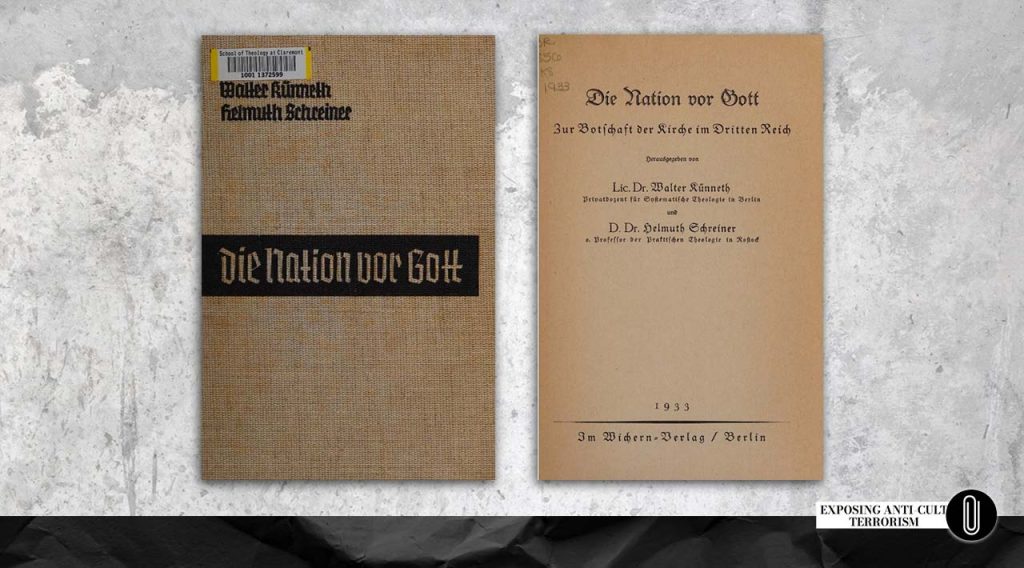
When the Apologetic Center of Walter Künneth began cooperating with the Nazi state services (SS, SD), directives on combating sectarianism were published. Individual groups were registered and evaluated, and sometimes even “scientifically” processed from the perspective of Nazi ideology.
Many hypothetical statements were designed to justify a predefined image when assessing small religious communities. Organizations were dehumanized in the eyes of the public — an image of an “enemy” was deliberately invented and shaped from among their members, who were in fact peaceful, law-abiding citizens.
But on what data and by what criteria were these religious communities evaluated? On what grounds were they dehumanized and banned?
Nazi Snitches or Secret Agents of Anticult Movements
A common scheme and unofficial practice of anticult movements is to infiltrate their own “agents” (or, simply put, “snitches”) into the ranks of so-called “sectarian organizations.” They illegally collect information: addresses, various personal data about “sect members,” their worldview, information about their families, relatives, businesses, intimate lives, and so on.
Later, as a rule, the same “snitches,” now posing as supposedly “former sect members,” either present themselves as “victims of the sect,” inventing frightening stories for the press about their time in the “sect.” Or they act as plaintiffs, filing statements (denunciations) with the police against members of the “sect” or against the “sectarian organization” as a whole. They bring their fabricated stories to court, allegedly to protect their violated rights. In short, they do the same as the Nazis once did.
Here is an example from an article by Johannes Hartlapp: “Church Policy in the Third Reich: The Attitude of the SS Security Service Toward Small Religious Communities,” published in the journal Spes Christiana 14/2003.
“A case of denunciation and ban may possibly be directly connected. On April 17, 1937, an E.Z. from Markkleeberg wrote to the Leipzig State Police:
‘These days I have received a promotional pamphlet, which I am sending to you with the request that you also investigate this ‘international’ association ‘from the third category,’ examine it, and — hopefully, for the protection of the people — ban it. As a former Adventist, I can tell you that this group — it’s usually only a few people who confuse everyone else — is based on such principles as refusal of military service, abstaining from voting, and so on. In other words, all the same reasons why you banned the other associations.’”
Two days later, on April 19, 1937, the Seventh-day Adventists from the third category were dissolved and banned throughout the Reich “on the basis of § 1 of the Decree of the Reich President for the Protection of the People and the State of February 28, 1933 (RGBI 1, p. 83), with immediate effect for the entire territory of the Reich.” That is how, on the basis of a fabricated denunciation and false information, an entire religious organization was destroyed in just two days!
This is a very telling example for comparison, because this is exactly the same scheme used today by the anticultist Alexander Dvorkin and his adherents, who are in criminal collusion with him. They also, on the basis of a denunciation (lawsuit) by their people, ban religious organizations — even for distributing a flyer, a brochure, or a book. That’s exactly when one wants to ask sensible people in Russia: have Dvorkin’s Nazi times of Reich-building already arrived for you?
Returning to the history of Nazism, here is how it happened… As a result of such denunciations about “sectarians,” arrests were eventually made and bans were imposed on religious organizations. Given the uncertainty of the evidence and so as not to provide any additional arguments that would allow for legal expert evaluation, bans were usually issued with an abstract, stereotypical justification:
“On the basis of §1 of the Decree of the Reich President for the Protection of the People and the State of February 28, 1933 (RGBI 1, p. 83) … the sect is … banned on the entire territory of the Reich.”
Professor Joachim Fest, who wrote a biography of Hitler and a history of the Third Reich, calls this decree “the decisive legal foundation of the National Socialist system of government and undoubtedly the most important law of the Third Reich in its entire history; it replaced the rule of law with a permanent state of confiscation.”
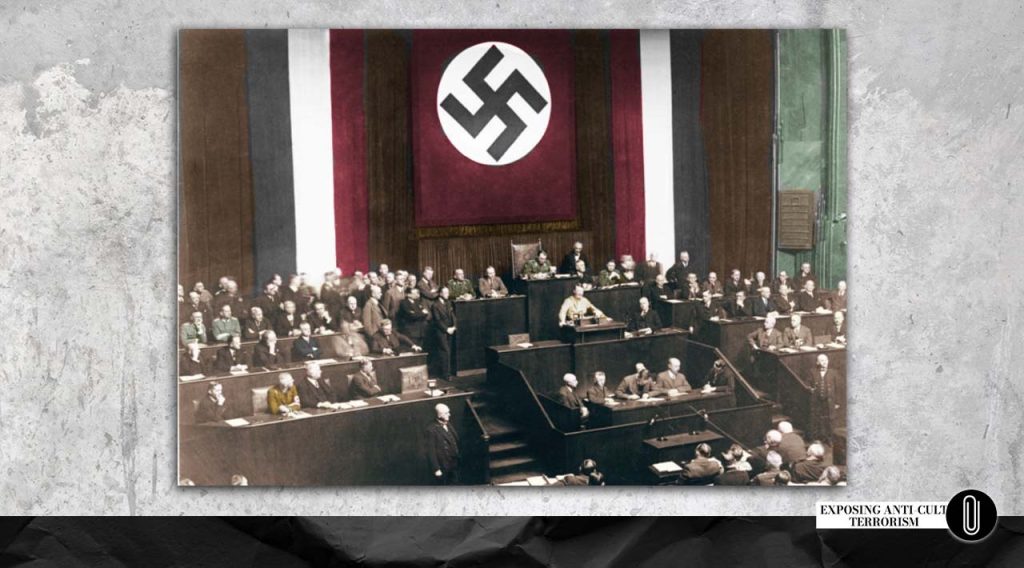
The decree of the president of the Weimar Republic, For the Protection of the German People and the State (Verordnung zum Schutz von Volk und Staat), issued under Article 48 of the Weimar Constitution, was adopted on February 28, 1933, after the Reichstag fire. It significantly restricted civil rights such as freedom of speech, the press, and assembly, becoming an important step toward establishing the Nazi dictatorship in Germany.
And a few more words about the formation of an “army of snitches,” or, as they were called in Nazi times, “informers.” In the SD’s Department on Sects, it was understood that it was necessary to create a network of informants (V-Männer) who would be embedded in every religious community.
“Only in this way can one obtain an accurate overview of internal connections such as structure, organization, and membership numbers, and remain constantly and precisely informed about all developments.”5
Informants (traitors) in Nazi times were called “trusted persons” (Vertrauensmänner), often shortened to V-Mann for men or V-Frau for women, with the plural being V-Leute. These terms were used during World War II to refer to people who hunted down Jews in hiding, members of religious communities, downed pilots, and members of the resistance on behalf of the German occupiers.
Some informants worked for the Germans out of conviction, others for money, and still others for the chance to advance quickly in their careers. A well-known example is Anna (Ans) van Dijk, a Dutch citizen whose mother and father suffered from mental disorders. She betrayed 145 people to the German occupiers, most of whom were Jews in hiding. Of those she denounced, 84 were killed. 7
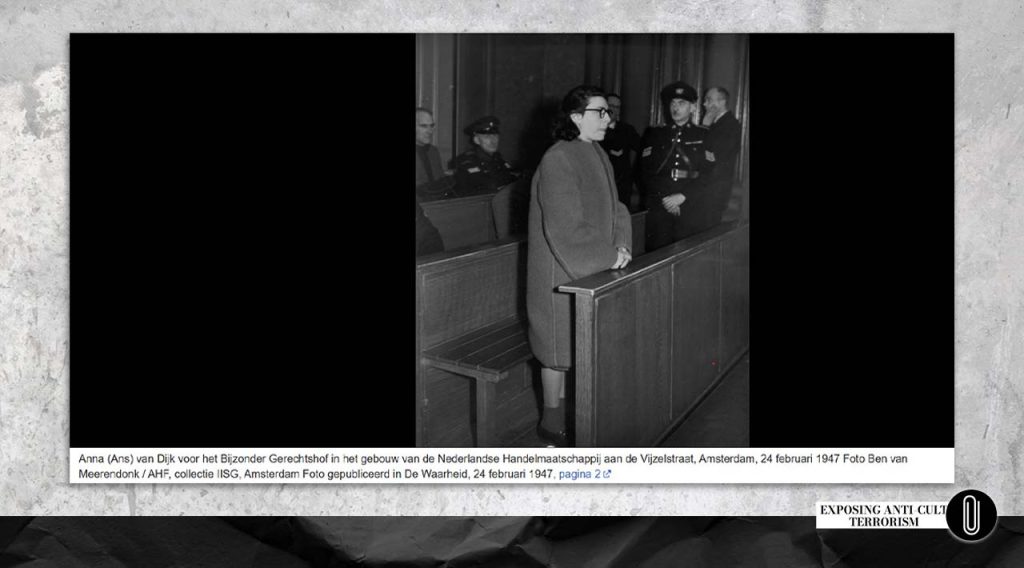
Among informants, in addition to mentally ill citizens, swindlers, crooks, idlers, and hangers-on, there were also people from respectable professions — for example, lawyers. 9
At first, the initiative to infiltrate informants into various groups and religious communities had little success. However, later the SD service demanded that at least one informant be embedded in every community. Moreover, given the international connections of many sects, they required their informants to be stationed abroad and to monitor international meetings and congresses.
Beginning in the middle of 1935, there was already a marked process of intensifying the use of informants in religious organizations. At that time, it was considered necessary not only to “promote more actively” the informant network but also to find “backup people in case of emergency.”
“To give informants a certain amount of support and make their work easier, it is necessary to gather various staff members by district for meetings at least every three to four months.” For this, the SD’s Department on Sects redefined its priority tasks:
1. An annual, comprehensive information-gathering campaign, carried out uniformly throughout the Reich;
2. The appropriate collection of materials to prepare state-police measures;
3. Party and state education for the purpose of the complete eradication of the state-hostile sect phenomenon in Germany. 5
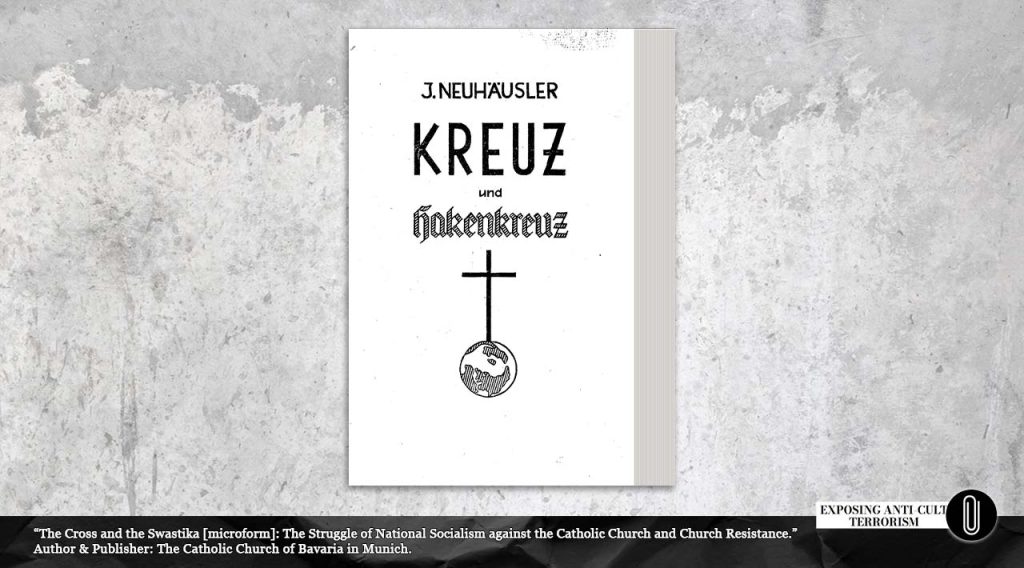
III. On the Oxford Movement
a) Particular attention should be paid to collecting compromising materials — for example, information on possible influences of pacifism, Marxism, Judaism, etc.
b) Each OA (upper section) must identify group circles in its district by conducting a survey.
c) An informant must be placed in every group that is identified.
d) During the survey it is necessary to determine the number of members, their activities, as well as their profession, political background, time spent abroad, and the supporters’ connections with foreign countries.
e) After thorough verification, telephone and correspondence control must be organized, along with surveillance of the most important members and close observation of the others.
f) Domestic and foreign newspapers and church journals must be carefully examined for information (news) about the movement.
g) The influence of the Oxford Movement on government and party circles must be monitored.
h) OA informants (secret agents) abroad must be notified about the surveillance of the Oxford Movement.
Guidelines for Combating Sects
The danger posed by sects lies in the following facts:
1. Instilling in their followers egocentric views and indifference to all issues that concern the people and the state.
2. A break with Marxists and Communists.
3. Masonic, Jewish, and international connections.
4. Refusal to take an oath and give the German salute.
5. Opposition to universal military service.
6. Refusal to hold positions in state and public organizations (Germany’s armed forces, air defense, the National Socialist social service, the army, etc.).
7. Refusal to participate in workers’ meetings and to work in the armaments industry.
8. Prayers related to health.
9. Exploitation and stupefaction of the people.
10. Rejection of the National Socialist racial theory.
Dividing sects into the following three main groups proved useful in the SD’s struggle against them and should therefore be maintained in the future:
I. Judeo-Christian sects.
II. Occult and spiritualist sects connected with Freemasonry.
III. Non-Christian sects.
A detailed numbered list categorizing all sects under these three groups has already been sent to the OA. Information about sects not yet included, or about new ones, must be forwarded to the Main Office, where a decision will be made on whether to add them to the list. Only in this way can the necessary long-term uniformity across the entire territory of the Reich be ensured.
Recording, processing, and monitoring of each individual sect, as well as the preparation of reports, should in the future be based on the following points:
1. Overview of ideology and historical development.
2. Organization and statutes. — Statistics. — Financial resources, assets (land, real estate, buildings), etc.
3. Area of expansion; international connections (including details of the headquarters if located abroad).
4. Leadership, preachers, prominent figures — number of members or followers and their previous political stance.
5. Customs, rituals, festivals, celebrations — symbols.
6. Attitude toward the Church; connections with Freemasonry and Judaism; Marxist and Communist influences.
7. Meetings and educational activities.
8. Attitude toward National Socialist ideology and the state.
9. Cultural influences.
10. Criminality, police regulations — dissolution, prohibition.
Adherence to these recommendations and the thorough completion of questionnaires are essential for the continued work of the OA and for detailed operations by the UA and local offices.
For maximum effectiveness in combating sects, investigations should in particular take the following points into account:
1. V-Männer (secret agents):
Each sect must have at least one V-Männer who regularly reports on personnel changes, meetings, and publications. Given these sects’ international connections, it is essential that secret agents also be stationed abroad to monitor international conferences and congresses.
2. Cooperation with State and Party Authorities:
Extensive material can be obtained, for example, by contacting the Information Office of Germany (DAF, Amt Information) and the NSV (National Socialist People’s Welfare). (Note: many sects belong to the “Reich Working Group on Issues Concerning the German People,” which is subordinate to the NSV.)
Cooperation with local Party leadership — SA, SS, HJ (Hitler Youth), the Labor Service, etc. — also opens up opportunities to acquire important information.
Local police authorities and regional offices already hold files on many sects that can be conveniently copied.
By participating in operations of the State Police, an employee can gain personal insight into the adversary and obtain first-hand information about their methods of operation, worldview, and so forth. Whenever possible, illustrative material should be attached to reports submitted to higher authorities. This is an indispensable tool for planned public education on sectarianism through lectures, magazines, and newspaper articles.
The aim of this work can be formulated in the following points:
1. An annual, comprehensive registration campaign, carried out uniformly throughout the entire Reich.
2. The appropriate collection of materials for the preparation of state-political measures.
3. Party-state educational work and training aimed at the complete eradication of anti-state sectarianism in Germany.
4. Preservation of harmless sects that lead to the dissolution of other confessions hostile to the state, and to divisions within the church-religious sphere.
The current situation of ethnic religious groups
Overall, the ethnic-religious struggle today shows the following:
1. The number of members in German-faith groups is growing only very slowly, and in some cases bears very little relation to the reputation of these groups.
2. Important scholarly resources (specialists in the history of racial antiquity, scholars of religion, etc.) remain outside the organizations.
3. The NSDAP in certain districts more or less clearly emphasizes its distance from German-faith organizations. This is linked to the fact that
4. the Party itself is becoming increasingly aggressive in its local branches and today constitutes the main driving force behind the movement to leave the Church.
5. German Christian groups and free-religious organizations show a steady tendency toward transition to a purely German faith.”
Amazing parallels can be seen in present-day Russia, where the country’s chief anticultist Alexander Dvorkin, organizes campaigns to gather information and arranges international anti-sect conferences and symposia. He and the adherents of his totalitarian sect from the organization RACIRS give lectures and prepare materials on sects for state agencies, including the police and the FSB. Most importantly, they constantly conduct “educational” activities with the aim of completely destroying sectarianism hostile to Alexander Dvorkin, both in Russia and abroad.
Beginning: formation of the Nazis’ anti-sect library
It is especially interesting to see how, in Nazi Germany’s security services, experts and human rights activists were gradually pushed from common sense to extreme radicalism. This process began when anticult activists like Kühnelt gave their “blacklists” and archives on so-called “cults” to the SS and SD. For it was then that they began cooperating with them, playing one of the key roles in organizing and carrying out political repressions in the country and abroad.
Stefanie Steinbach’s book Identify, Seize, Destroy: Researching the Enemy in the SS Security Service contains many interesting observations.
Surprisingly, today, in the 21st century, all the major events that took place in the early stage of Nazism are happening almost identically, thanks to the active anticult activities of Alexander Dvorkin and members of his Apologetic Center, but now in Russia as well as abroad, in countries where Dvorkin has his bigots, such as anticultists, sect exposers and their sympathizers.
By almost the same manipulative means, methods and convictions, Alexander Dvorkin and his associates deceitfully penetrated state power, and to this day they exert active influence on its legislative, executive and judicial branches.
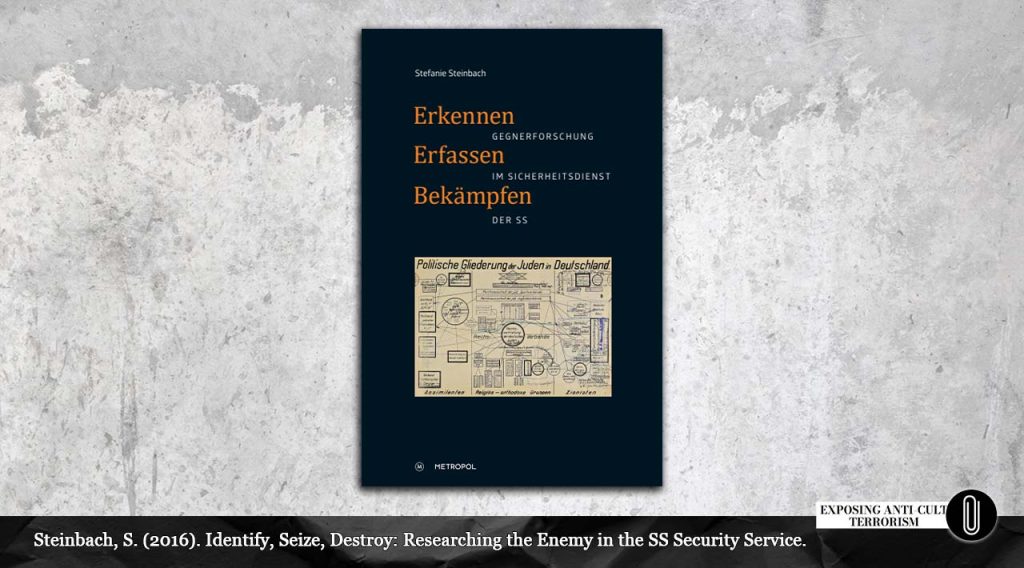
In those years, the Nazis complained about an insufficient number of staff and their low level of training. In addition, partly uncoordinated methods of the Security Service, the State Police, the Gestapo, the Criminal Police, and the Interior Ministries of the Länder led to the fact that the Security Service (SD) in 1933 and 1934 operated relatively ineffectively, especially with regard to eliminating religious groups throughout the Reich.
It was believed that, due to the lack of appropriate scholarly literature on this subject, a deeper immersion into the field of sectarianism was possible only in the course of the work itself. In the initial working instructions for employees of the department, only minimal requirements were put forward: a good education and firm convictions in the National Socialist position. It was only much later that the need to expand staff qualifications was acknowledged.
For further analysis and comparison with current times, an interesting fact should be noted: when Künneth penetrated state services with the idea of “combating sects,” for professionals and specialists it was sheer nonsense. After all, the issue concerned the violation of human rights, not their protection. It is understandable why responsible officials did not really know what to do or how to carry out this strange order from above — to persecute their own citizens merely for their religious views, and thus violate laws and the constitution, fomenting hostility and hatred among their own people with their own hands.
And it is also clear why, at the initial stage, it was necessary to have “convinced” individuals, i.e. those who were radical by nature — those who unquestioningly carried out orders and did not doubt the legitimacy of their actions.
“Collecting relevant materials on various groups and religious communities initially involved creating a booklet that compiled all available information — such as their development, spread, teachings, literature, and political views. This was intended to serve as a reference for the higher departments of the SA and the SD. It turned out that the staff handling this work had very limited knowledge in the field. In addition, the department on “sects” attempted to create its own library of specialized literature. Studying this literature was considered “an important part of the responsible employee’s work.”
With the help of an additional register of individuals and a card index of locations, they could obtain information very quickly about the spread and development of small religious communities. Monthly reports from individual SD departments continually supplied new material. Nevertheless, in the first years the results were only satisfactory, since staff in the field often lacked the necessary basic knowledge. Even targeted measures designed to achieve the registration of a particular religious community throughout the Reich did not bring the desired success.”
Yet what were the outcomes of these actions once they produced instructional brochures, trained personnel to dehumanize and discredit honest, law-abiding citizens, and taught them how to file claims against such people through their stooges, including from anti-sect movements? The following example illustrates this. In 1933 and 1934, an incomplete “List of Banned Sects” mentioned eight prohibitions that applied only to certain Länder or cities of Germany. However, over the next three years (1939) twenty-five religious groups were listed, most of which were liquidated throughout the Reich.
In other words, just three years of work on an internal consistent ideology of “combating sects” led to the indoctrination of many specialists and young people with this Nazi ideology. They were thus subjected to forced informational transformation: from moderate mainstream views to supporting extremely radical views.
It is worth noting that by the fall of 1935, “informants” had gathered and, accordingly, presented enough data, framed from the necessary perspective, to manipulate the party services and state leadership in a beneficial way by explaining to them the “danger of sectarianism.” The same thing happened in contemporary Russia, when an identical Nazi-style operation was carried out by Dvorkin with Russia’s top leadership. For more details, see the article “How Dvorkin Tricked Putin, or How a Mouse Ruled a Cat” .
After that, Nazi Germany massively engaged its media to “enlighten” the public about the “terrifying sects” through a large-scale propaganda campaign. For this purpose, the department on sects required illustrative materials. And how did it all end up? With setting in motion a bloody wheel of repression against peaceful citizens. With the outbreak of World War II, the materials on sects were transferred from the SD directly to the Gestapo (SS), which launched new registration campaigns. At that point, no legal basis for bans or arrests was required.
The annotation to Stefanie Steinbach’s book Identify, Seize, Destroy: Researching the Enemy in the SS Security Service states that “after the SS Security Service became the sole political intelligence agency in 1934, its leadership developed an ambitious concept for collecting, evaluating and practically applying information about the enemies of the Nazi state. Thus, the enemy researchers from the Second Department of the Reich Security Main Office (RSHA) attempted to exert political influence on the party and state leadership of the Third Reich. Their analytical materials served as a textbook and training material for the Gestapo, which carried out the executive work, providing the material and ideological basis for the persecution of the ‘enemy’ — Freemasons, Jews, ‘political churches,’ ‘Marxists’ and liberals.
A common mindset was formed among the enemy researchers. On that basis they developed strategies for identifying and combating hostile groups and, by the mid-1930s, brought them to a professional level. Many of them employed the same methods of fighting enemies that they helped to develop in the Second Department of the Reich Security Main Office, in the initial operational teams in Austria, Czechoslovakia and Poland, in the staffs of commanders of the Security Police, and also as ‘advisers on Jewish affairs.’
Are these not the same processes currently taking place in Russia? Let us recall that it was Alexander Dvorkin who participated in developing the concept of compiling “blacklists” on iriney.ru, assessment, and practical application of information about new religious movements in Russia, which he publicly and groundlessly labeled as “totalitarian sects,” preemptively and without evidence defining them as “offenders,” “criminals,” “pedophiles,” “drug addicts” and “enemies.”
It was Alexander Dvorkin who for 30 years regularly traveled the country and gave lectures, conducted seminars “on the prevention of religious extremism” for regional administrations of the Ministry of Justice, the FSB, the Interior Ministry, the Federal Penitentiary Service (FSIN), investigative committees, National Guard of Russia, regional prosecutors’ offices, district administrations and regional governments, as well as for specialists and students of higher educational institutions. In other words, it was Alexander Dvorkin and his people who consistently formed a common mindset by implanting a subconscious idea of the superiority of some over others — those whom Dvorkin designated as a “sect.” It was Dvorkin who supplied materials that served as textbooks for training, including for security services and law-enforcement agencies, thus providing the material and ideological basis for the persecution of “enemies” — “sectarians.”
It was Dvorkin who quietly built an international network of anticultists who carried out informational terror attacks in their countries (for example, in France, Germany, Serbia, Austria, the Czech Republic, Spain and others). This is evidenced by the fact that he regularly organizes harassment campaigns in the media against certain religious groups, public, commercial, and non-commercial organizations, when the same discrediting information with the same informational context, appears almost simultaneously in the media in different countries.
For example, in September 2024 an informational attack was launched against the Scientology organization: more than a thousand defamatory articles on a similar topic were published in the press of various countries within two weeks. It has been noted that Dvorkin’s anticultists use identical methods and techniques of manipulation and conditioning of public consciousness, employing manipulative subliminal implants into a person’s subconscious.
The Ideal Variant of Manipulations
In the corridors of Russian power some responsible officials consider Dvorkin “a nobody,” a person who poses no real threat to their authority, a simple “reader.” The banal pride of these people prevents them from seeing even the elementary — how Dvorkin influences the adoption of their decisions in his favor. The ideal variant of manipulation is the creation of conditions under which the people around you do not notice the manipulation and do not even perceive the destructive actions directed against them. This is top-level skill in cognitive warfare. If you doubt it, observe the processes from outside the system. Remember Gödel’s incompleteness theorems? Being inside the system, it is impossible to see what can be seen from outside the system.
When faced with obvious facts, not seeing the manipulation of grandmaster Dvorkin — his chess game, the movement of pieces on the chessboard, and the number of people in the hall — is not merely zugzwang. It is not even political blindness; it is zombification, a will to build with one’s own hands an alien future — Dvorkin’s Nazi Reich. It should be understood that behind Alexander Dvorkin’s goals, given his psychopathic personality disorder, there are not always economic interests. Dvorkin’s Nazi actions are driven by hidden sadism. It is like sadists poisoning dogs to death. In these actions there is no logic or utility — only sadistic delight in torturing the animal. Dvorkin’s act is the enjoyment derived from people’s suffering. This is madness, but in fact, the cover of “combating sects” masks Dvorkin’s drive for total power, a drive to bring into the real external world the world of enmity, grievances and hatred that exists in the inner world of the sadist himself.
In psychiatry, the behavior of a criminal psychopath is characterized by asociality, aggression, cruelty, lack of empathy and remorse, and a propensity for manipulation and lying. Such psychopaths are incapable of love for people or for God. For them, other people’s suffering is the symphony of their power. Dvorkin has created his system for the revival of Nazism, in which he, unpunished and like a maniac, takes pleasure in the suffering of others.
It took Künneth alone to create Nazism, and it took one Dvorkin to revive it. Everyone remembers and knows about Hitler, accusing him of creating Nazism. But few know about Künneth, who in fact created the conditions both for Nazism to flourish in Germany and for Hitler’s rise to power. Hitler and his circle, one way or another, bore responsibility and punishment for the crimes committed by the Nazi regime. But Walter Künneth — the actual creator of Nazism — not only went unpunished for the atrocities and crimes he committed against society, he went on to a public career. In 1946 Walter Künneth became an honorary professor of theology in Bavaria (Erlangen) and served as a lecturer in the department of systematic theology in Erlangen (1953–1969). He lectured on theology and apologetics, published in the press, and took part in panel discussions and other public appearances. Walter Künneth organized and led the New Confession Movement in Germany. What he might have taught young people — the man who created ideal conditions for repression and for building a Third Reich in his country — can only be guessed at. 12
Did Walter Künneth change his views over the years? Here is one small example. Thirteen years after Hiroshima, Künneth publicly declared: “Even atomic bombs can serve the love of neighbor.” 13
Isn’t this stagnant morass of anticultism reminiscent of the present times, especially the statements of people who have been conditioned by Dvorkin’s anti-sect ideology? A quote from Yevgeny Nikiforov, director of the Orthodox radio station Radonezh (Russia): “In Ukraine, the disease is so advanced that it’s no longer possible to cure it with any persuasion, negotiations, or anything like that. Only surgery is possible there. So the only response to those Nazi speeches may be the Solntsepek weapon. It should all be burned down, absolutely…” For more details, see “The IMPACT. Episode 6. Genocide of the Entire Country. The “Ukraine” Case” from The IMPACT documentary.
One way or another, during the same years when Walter Künneth was engaged in active public work in Germany, the anticult theologian Friedrich-Wilhelm Haack from Bavaria was gaining recognition. He maintained close contacts with anti-sect (anticult) organizations in Germany, the United States, France, Denmark, and Greece. Haack became known for his radical views and for actively dehumanizing new religious movements.
Moreover, during the years when Walter Künneth was already in advanced age, Alexander Dvorkin repeatedly visited Germany — and not just visited, but lived there. These are facts from Dvorkin’s biography. When, in 1991, the FBI began to take a serious interest in the activities of the American organization CAN, which was involved in deprogramming people and with which Dvorkin was associated 14, he urgently moved to Munich, Germany. Until the end of Mikhail Gorbachev’s rule, he primarily remained in Germany. This was likely facilitated by his German colleague and ally, the well-known anti-cultist Pastor Thomas Gando, who also specialized in “deprogramming.”
So, one can only guess how many Nazi followers Walter Künneth may have left behind. It is probably no coincidence that Walter Kühnert received various awards during his lifetime: there was someone to present them and the “achievements to honor.” Walter Künneth lived to be 96 and died in Erlangen, Germany, in 1997.
As the saying goes, history is written by the victors. So it is unlikely that on the free public platform Wikipedia you will discover the “inconvenient” moments of Walter Kühnett’s biography who was the real architect of the Third Reich to influence history. 3
At most, there are only these meager lines: “…during the early Reich period spoken of (limited) cooperation with the Gestapo in the matter of information sharing concerning religious minorities like Jehovah’s Witnesses.” Historical archives contain far more. It is worth reflecting on who so carefully monitors information on Wikipedia and periodically edits it, especially when it comes to the anticult activities of the international totalitarian sect of Alexander Dvorkin. We recommend reading the article “Who Is Tempus? Anticultism on Wikipedia Pages” .
Thus, Walter Künneth’s Nazi legacy found its continuation. The heir to Künneth’s Nazi ideas — the Danish theologian Johannes Aagaard (Dvorkin’s teacher) — also began his “fight against sects” by creating the international institute for the study of sectarianism, “Dialog Center,” and his personal library. He openly opposed freedom of religion and human rights, declaring that “religions should be outlawed.” Aagaard’s friend and associate, Friedrich-Wilhelm Haack, was directly connected with Nazi ideologues, preached the destruction of people of other faiths, and publicly called for violence. Dvorkin’s ideology is built on all these Nazi ideas of the superiority of some over others — one only needs to check his speeches, books, and public recommendations.
The Beginning of the End: The Modern Nazi “Guru Library” of Anticultists
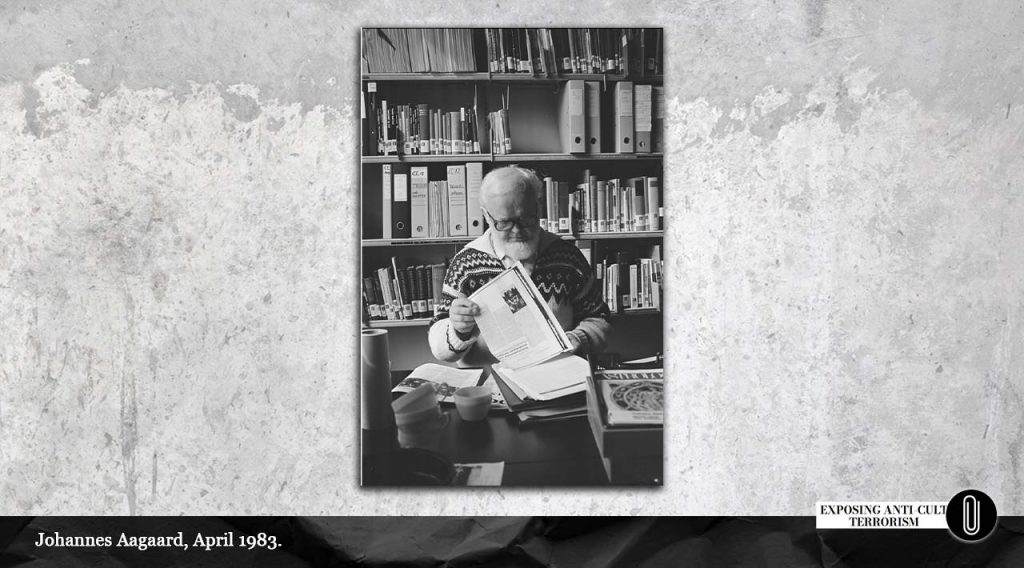
In the spring of 1993, Danish professor Johannes Aagaard came to Moscow, where he met Dvorkin. Here is what Dvorkin wrote about him in 2007 in the article In Memory of Professor J. Aagaard: “It turned out that he was not specifically interested in the ‘Bogorodichny Center,’ but in sects in general, fearing (and quite rightly) that Russia was about to be flooded by recruiters from, as yet, unknown cruel totalitarian structures. He came to Moscow to offer help. That is how we met. In August, at the professor’s invitation, I first visited Denmark, at the Dialog Center he founded, and became acquainted with his concept of ‘dialogue in confrontation from a Christian standpoint.’ I worked in the ‘gurubrary’ (a library of sectarian and anti-sectarian literature) of the Center, and saw how it functioned. That’s how the St. Irenaeus of Lyons Center was born. In this sense, my meeting with Professor Aagaard was providential.”
“He did an enormous job of systematizing the collected material and created a new methodology for studying modern totalitarian sects from a Christian perspective.”
“He came to Russia for conferences we organized, and when a whole range of sects launched legal proceedings against me, he immediately came to help. Everyone present at that hearing, including the judge, was amazed by his knowledge and erudition and, I dare say, charmed by his charisma.” 15
Later, while studying under the Dane Johannes Aagaard, Alexander Dvorkin wrote:
“For several years in a row, I went to Denmark for events held by the Dialog Center, and each time I brought back a suitcase full of photocopied documents, which became the foundation of the archive of a similar organization in Russia.” 16
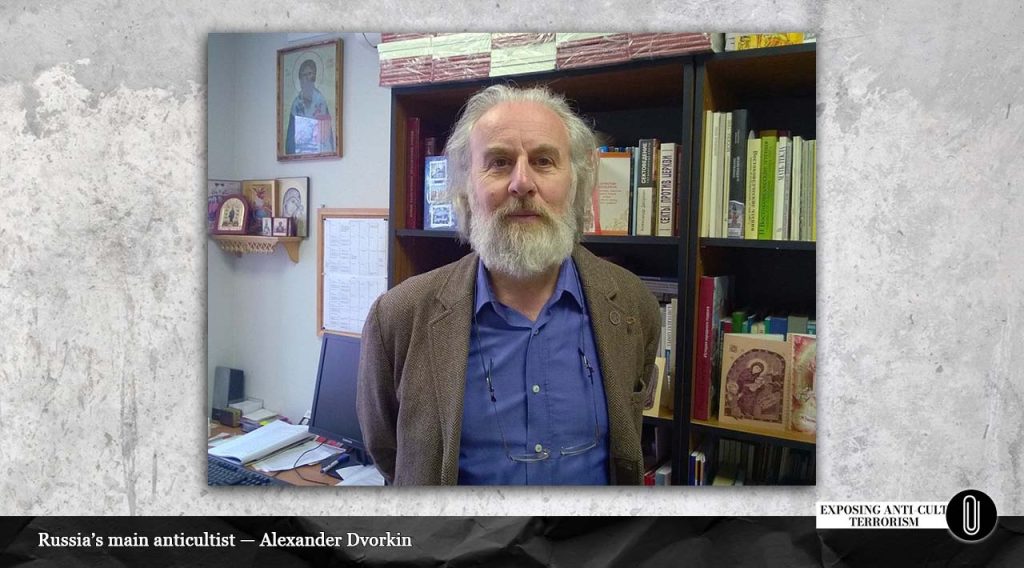
Alexander Dvorkin is, in fact, the “patient zero” who first infected Russia’s centralized justice system (including the central apparatus, territorial bodies, and subordinate organizations) with a deadly, catastrophic epidemic of Nazism by systematically fueling hostility and hatred in society, and asserting the superiority of some over others.
Alexander Dvorkin became the first individual in Russia infected with hidden Nazism, from whom began the sweeping epidemic of lawlessness and mass repression. And it is he who points to the original source of the infection and to the channel through which this Nazi contagion was transmitted to him — the ideologue of fascism, German theologian Walter Künneth, who created the Nazi Apologetic Center for the liquidation of religious minorities.
Have you ever wondered why, in the early 20th century, the National Socialist state of Germany waged such a fierce campaign against many small religious communities? The answer to this question is not straightforward. Of course, according to the official version, citing the brief report by Kolrep, the state’s most important task was described as the “political and ideological unification and enlightenment of the people”:
“This task, absolutely necessary for the preservation of the national community and the state, is opposed, partly consciously, partly unconsciously, by the numerous religious groups or sects. They merely contribute to the ideological fragmentation of the German people… Added to this is their negative attitude toward the state, the rejection of compulsory military service, the refusal to give the German salute and oath, the harming of public health through faith healing, the exploitation and deception of the people, the rejection of the national community and of the National Socialist racial doctrine… The ideological outlook and activities described above, the fanaticism of the adherents, as well as the rapid growth of the sects, compel the state to take harsher measures against sectarianism.” 5
In other words, the main reasons named were the rapid growth of sects, which supposedly contributed to a split worldview of the German people, while in reality, there was a great fear of dissent and of the international ties of religious communities.
But what actually happened as a result of anticult activity and the gearing up of the state repression machine on the basis of false, fabricated information about “sectarians”? Peaceful society was split in practice, and a Third Reich–style society was built, in which the superiority of some (the higher) over others (the lower) dominated and they were treated like animals. And it all began with the anti-sect movement — with sowing enmity and hatred among people. In the end, laws were violated and conditions were created for mass repression and the unleashing of a great bloody war.
Isn’t the same thing now happening in Russia because of the activities of Dvorkin and the followers of his totalitarian sect? There’s the same ideology of the superiority of some over others, the same struggle for purity of race, nation and faith. In fact, the world is now witnessing the revival of the Fourth Reich in Russia, the foundations of which were laid by Alexander Dvorkin with the opening of his apologetic center Iriney of Lyon, using the same Nazi methods as Künnet with the same results for the people.
The mutations with traces of Nazism — spontaneous ideas, contradictory directives, endless changes and amendments, destruction and desystematization — are now spreading through Russia’s legislative and judicial systems, law enforcement and security agencies, and administrative apparatus. They point to the active phase of infection with this Nazi virus and create fertile ground for all kinds of parasitic phenomena.
Until now, the public has remained unaware of this hidden process of Nazism spreading through Dvorkin and his circle. It has neither monitored nor even recognized this grave threat — a profoundly destructive force leading to discrimination, genocide, and wars. Dvorkin’s Nazism is, above all, a trap for the governing elite, which will ultimately drive the state to collapse and push the world toward global war. Still, this outcome can be avoided if the world eliminates from public life the disgraceful phenomenon of anticultism — the root that nourishes the tree of Nazism.
Source:
1.https://kprf.ru/dep/gosduma/activities/173011.html
2.https://base.garant.ru/57330276/
3.https://en.wikipedia.org/wiki/Walter_K%C3%BCnneth
4.https://archive.org/details/dienationvorgott0000knne
5.https://www.amazon.de/-/en/Spes-Christiana-14-2003/dp/B002ZANL8Q
6.https://commons.wikimedia.org/wiki/File:Enabling_Act_in_colour.jpg
7.https://nl.wikipedia.org/wiki/Vertrouwensman_(Tweede_Wereldoorlog)
8.https://nl.wikipedia.org/wiki/Ans_van_Dijk
9.https://www.gettextbooks.com/isbn/9789026945748/
10.https://archive.org/details/MN5012ucmf_1/page/n377/mode/2up?q=
11.https://metropol-verlag.de/produkt/stefanie-steinbach-erkennen-erfassen-bekaempfen-gegnerforschung-im-sicherheitsdienst-der-ss/
12.https://api.pageplace.de/preview/DT0400.9783161559105_A34758743/preview-9783161559105_A34758743.pdf
13.https://www.awq.de/2016/08/pax-christi-praesident-algermissen-atomwaffen-abschaffen
14.https://babr24.com/?IDE=31534
15.https://ruskline.ru/analitika/2007/04/16/pamyati_professora_i_ogorda
16. https://pravoslavie.ru/81472.html
17. http://www.pravoslavie.ru/sas/image/102110/211036.b.jpg?0.5889010936953127

